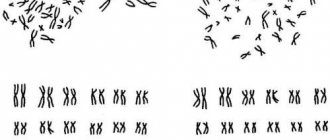Acute leukemia in children
With acute malignant lesions of the hematopoietic organs, young patients end up in oncology clinics much more often than adults. This negative feature can only be explained by the fact that in early childhood the final formation of all body systems that are not fully matured during intrauterine development occurs (the bone marrow, the cells of which are directly involved in the development of acute leukemia, precisely belongs to this category).
Oncological disease has some features associated with childhood:
- Most susceptible to acute leukemia are children with Down syndrome and babies whose mothers, while carrying a child, did not give up their addictions;
- childhood acute leukemia has a more aggressive course than in adults and is resistant to antitumor therapy, as well as high mortality;
- the incidence of diseases of this etiology in childhood is approximately 30% of all cancers;
- Most often, the first and alarming symptoms of blood cancer in children appear between the ages of 2 and 5 years.
Read here: Treatment of cervical cancer
Acute leukemia in adults
The most common form of acute leukemia in adults is acute myeloid leukemia (AML). The prevalence of this disease is 1 in 100,000 people over 30 years of age and 1 in 10,000 people over 65 years of age. The causes of acute myeloid leukemia in adults are not fully understood.
It is assumed that this is facilitated by ionizing radiation and frequent contact with petroleum products, as well as chemotherapy during the treatment of other tumors. There are also other possible risk factors, such as exposure to various environmental factors, congenital genetic defects, or other diseases of the hematopoietic system.
The second most common acute leukemia among adults is acute lymphoblastic leukemia (ALL), which accounts for about 10-20% of acute leukemia cases in adults, and which is the most common form in children.
The causes of acute lymphoblastic leukemia are not yet known. The peak incidence of this disease occurs between 3 and 7 years of age. In adults, it mainly affects young people under the age of 30. Has nonspecific symptoms - weakness, fever, joint pain.
Symptoms of acute leukemia:
- Symptoms of influenza are fever, weakness, bone pain, symptoms of inflammation of the respiratory tract.
- Symptoms of the so-called purpura - bleeding from mucous membranes, mainly from the gums, nose, gastrointestinal tract or genital tract and hemorrhagic purpura on the skin and membranes.
- Symptoms associated with weakened immunity - frequent colds, activation of herpes, poor health, lack of appetite, bacterial and fungal infections, erosion on the membranes, etc.
- In addition, leukemia causes a number of other symptoms, not all of which occur in all patients and are not typical for leukemia. But they are very “valuable” in diagnosing the disease.
- With acute lymphoblastic leukemia, an enlargement of the spleen and/or lymph nodes occurs in 75% of patients, which allows for preliminary differentiation in relation to acute myeloid leukemia.
- Some patients with lymphoblastic leukemia also experience problems with blood flow in small vessels as a result of blockages of blood cells, most often when the number of white blood cells in the blood is significantly higher than normal. This may manifest itself in the form of visual or mental disturbances.
During acute leukemia, rapid diagnosis and immediate treatment are very important. Acute leukemia, if left untreated, usually leads to death within a few weeks.
Differentiation of the type of leukemia is usually not possible based solely on external symptoms. They are similar not only for the two types of acute leukemia, but also for other diseases such as infectious mononucleosis.
The diagnosis is made on the basis of laboratory tests - morphology, cytogenetic and molecular studies and immunophenotyping. Thanks to this, it is possible not only to confirm the diagnosis of acute leukemia, but also to determine its type, as well as its subtype, which allows us to assess the prognosis and take treatment that gives the greatest chance of cure with minimal risk of complications.
In patients with acute lymphoblastic leukemia, a significant number of white blood cells are observed in the peripheral blood, the number of which increases rapidly. In addition, the number of red blood cells and platelets in the blood usually decreases. The smear shows lymphoblasts, that is, immature forms of white blood cells. The same applies to material obtained from bone marrow.
Bone marrow biopsy is the basis for the preliminary diagnosis of acute lymphoblastic leukemia. Bone marrow is obtained from the sternum or thigh area. The procedure is performed under local anesthesia - after anesthesia, the doctor uses a special needle to cut into the bone where the bone marrow is located and obtain a sample. The bone marrow puncture itself is usually painless; the patient may, however, feel gentle suction or expansion.
After the biopsy, the doctor evaluates the bone marrow under a microscope, provided that the material is properly prepared, which allows the cells to be assessed. The type of T-lymphocytes that have changed is assessed, the number and size of cancer cells are determined, and a specialized cytogenetic analysis is performed, which determines the type of changes in the set of cell genes and their mutations. The diagnosis of acute lymphoblastic leukemia is made when there are about 20% lymphoblasts in the blood or bone marrow.
To assess the progression of the disease, organ function studies are also carried out:
- Abdominal ultrasound, possibly computed tomography/magnetic resonance.
- X-ray of the lungs, possibly CT scan/magnetic resonance.
Treatment of acute leukemia is divided into three stages.
In the first, so-called induction phase, which lasts only 4-6 weeks, high doses of drugs are prescribed, the purpose of which is to remove the tumor. Induction for acute lymphoblastic leukemia consists of using properly selected chemotherapy (anthracycline, prednisolone, L-asparaginase).
In the second stage, the so-called consolidation phase, which usually lasts 3-6 months, smaller doses of drugs are prescribed, and its goal is to eliminate the remnants of the disease. Treatment of acute lymphoblastic leukemia at this stage consists of the use of cytostatics (Ara-C, methotrexate). In addition, treatment is prescribed to protect the central nervous system.
The third phase is post-consolidation treatment, that is, it prevents the return of leukemia for a long period after the end of the second phase. The use of specific drugs is determined individually, based on the type and subtype of leukemia, the patient's health status, response to previously used drugs, etc. The goal of treatment is to reduce the number of active cells so much that the patient's immune system can handle them.
Chemotherapy used to treat acute forms of leukemia usually damages the bone marrow, requiring a bone marrow transplant. In the third stage of treatment of acute lymphoblastic leukemia, therapy based on the prevention and treatment of infections, viral hemorrhagic disease and anemia to treat metabolic disorders is very important. Psychological support is also important.
Treatment of acute leukemia is associated with a high risk of complications. The most common of these is the so-called tumor breakdown syndrome, which is associated with the destruction of cells during intensive chemotherapy.
A sharp decrease in the number of white blood cells and platelets in the blood, which usually occurs at least two weeks after the start of treatment, can lead to severe infections and bleeding associated with bleeding diathesis. Infection and bleeding are usually the immediate cause of death during treatment of acute leukemia.
The prognosis depends on the form of leukemia, the health status and age of the patient. In the case of ALL in children, complete recovery occurs in 80% of cases in adults, in 45-60% of cases. The prognosis is worse in older people and largely depends on the subtype of leukemia.
The relatively high survival rates are due to the rapid development of pharmacology in this area in recent years. Back in the sixties, patients had no chance of survival. For AML, the chance of recovery also depends on the patient's age and health, the type of molecular changes and disease progression, and ranges from 10 to 80%. Young people who have no changes outside the bone marrow and who respond well to chemotherapy have the best chance.
In young people, intensive chemotherapy leads to a 40% cure rate, and when combined with a bone marrow transplant, even 60%. While in patients over 60 years of age, only approximately 10% of them live longer than 5 years. This is associated with more damaging molecular and cytogenetic changes in these individuals and poorer overall health. In any case, a detailed prognosis is determined by the attending physician based on the type of gene changes, disease progression and general health, age and gender of the patient.
Classification of acute leukemia
It is possible to select the optimal program for acute forms of leukemia only when the nature of the dangerous disease is fully known. To identify it, diagnostic studies are carried out, the results of which are systematized in the international FAB classification.
Only an experienced hemato-oncologist can fully understand it, but for general information it is worth mentioning 2 main forms of acute leukemia, which are the most common:
- Acute lymphoblastic leukemia (ALL). This form of the disease is characterized by uncontrolled division of immature lymphocytes and the formation of small, large, or blast cells of the hematopoietic system with altered cytoplasm.
- Acute non-lymphoblastic leukemia (ANL). This category includes: myeloblastic leukemia, the precursors of which are granulocytes (granular white blood cells), megakaryoblastic leukemia, developing from immature platelets, and monoblastic, provoked by the active division of monocytes, a type of leukemia.
All subtypes of acute leukemia require specific therapy, since they differ in genetic, immunological and morphological properties.
Classification of leukemia
In modern times, there are two types of acute leukemia: myeloblastic (AML) and lymphoblastic (ALL). The myeloblastic type of disease is characterized by rapid growth of immature leukocytes; with prolonged development of the disease, mutation of myeloblasts occurs and their further transformation into other substances: eosinophil, basophil, or neutrophil. With the development of this form of the disease, the following are distinguished:
- acute form of non-lymphoblastic leukemia;
- myeloblastic without maturation;
- promyeloblastic leukemia;
- megakaryoblastic leukemia;
- myelomonoblastic leukemia;
- erythroleukemia;
- monoblastic leukemia.
Although some of these types of adult leukemia are considered separate diseases, the difference between them is only chemical. ALL is a cancerous disease of the circulatory system, which is characterized by rapid development. In the absence of proper therapy within 3-6 months, cancer cells will affect all internal organs, and the disease will end in death.
Causes that provoke the development of acute leukemia
For what reason hematopoietic cells, the production of which mostly occurs in the bone marrow, begin to mutate is still not known. Most scientists are inclined to the direct influence of the genetic factor, but, as statistical data show, it does not play a fundamental role, since a significant number of people with poor heredity live to a ripe old age without ever feeling the symptoms of acute leukemia. Although the main causes of cancer of the hematopoietic system and peripheral blood have not been identified, experts have every reason to point to risk factors that increase the chances of the onset of the pathological process and accelerate its progression.
These include:
- Radiation, chemical or toxicological effects. The chances of developing acute leukemia increase in people living in areas with unfavorable environmental conditions, near large factories or nuclear power plants.
- Pathologies associated with changes in the chromosome set (Klinefelter's disease, Down syndrome, etc.). These reasons are the main risk factors for the development of acute leukemia in children.
- The influence of pathogenic viruses. Some viral infections (herpes, influenza) increase the risk of an abnormal response of the immune system to the causative agents of these diseases.
There is an influence on the development of acute leukemia and the presence of a person’s history of blood diseases (certain types of anemia, myelodysplasia). In most cases, as clinical practice shows, acute leukemia develops under the simultaneous influence of several causes that aggravate each other, for example, the impact of an unfavorable environmental situation increases if a person has a hereditary predisposition to cancer.
Causes
The reasons for the appearance of a malignant clone in human blood are not precisely known, but oncologists note some provoking factors:
- Ionizing radiation. Here, workers in the X-ray room, patients after radiation therapy, etc. are at risk.
- Frequent and prolonged contact with a number of chemicals, for example, toluene (found in most varnishes and paints).
- Use of pesticides in agriculture.
- Long-term use of drugs such as Chloramphenicol.
- Polluted environment - exhaust, smoking, etc.
- T-lymphotropic human virus.
- With the development of leukemia in children, a hereditary factor is often noted, which manifests itself after several generations.
Symptoms indicating the development of acute leukemia
It is very difficult to recognize the acute form of leukemia at the inception stage, since the first manifestations of the pathological condition cannot be called specific. They are more reminiscent of the development of a common cold, so people who experience them do not seek to visit a specialist, but begin to independently treat the so-called cold. Symptoms, the appearance of which should cause alarm in a person, appear after the tumor process that has affected the hematopoietic cells of the bone marrow begins to progress. But even at this stage it is not too late to suppress the development of the disease.
Read here: Radiation treatment for cervical cancer
You should urgently contact a specialist if one or more of the following signs appear:
- unexpected appearance of joint or bone pain that occurs not only during movements, but also at rest;
- bleeding gums, frequent and heavy nosebleeds, the appearance of bruises on the skin without mechanical impact;
- pronounced enlargement of lymph nodes without their acquisition of pain;
- constant pallor or obvious yellowness of the skin;
- unexplained appearance of cardiovascular disorders (muffled heart sounds, tachycardia, in rare cases, expansion of the boundaries of the heart muscle).
After the transition of acute leukemia to the metastatic stage in children and adults, signs may appear indicating disturbances in the functioning of the central nervous system. Their presence indicates that the blast cells of their hematopoietic organs have metastasized into the nervous system.
Important! If these signs appear, you should never self-medicate. The only correct decision a person can make in this case is to seek professional medical advice. Only timely detection and initiation of treatment for progressive acute leukemia will allow long-term remission to be achieved.
Symptoms
The clinic depends on the stage of the disorder. Accordingly, the manifestations will be like this.
First stage
As stated earlier, there are no specific signs yet. There are general asthenic moments:
- Weakness. Feeling overwhelmed. By the end, there is no strength left to even get out of bed, and there is no such desire. Apathy is growing.
- Drowsiness. Constant need to take a nap. Occurs due to insufficient blood circulation in the brain. The pathological process is not yet so advanced. Cell maturation is slightly below normal. But the violation is already present.
- Loss of appetite. Reluctance to eat anything. In particularly advanced cases, the patient completely refuses food. The very thought makes him sick. Regardless of what is offered to him.
- Increased body temperature. Hyperthermia. How strong it is depends on the characteristics of the individual person’s body. As a rule, it rarely exceeds 37.5 degrees Celsius.
- Decline in performance. Unable to perform professional duties. As it progresses, the patient loses the ability to even take care of himself at home. Although physically the ability remains. Lack of strength and energy.
- Decreased endurance and tolerance to physical activity. At this stage, the manifestation is not yet so pronounced. It can be noticed if you increase mechanical activity. Quickly walk, jog, climb the stairs. Shortness of breath and palpitations occur.
At this stage it is easiest to cope with the disease. The forecasts are the most favorable.
Second stage
Symptoms of leukemia become obvious and specific. In addition to those that already exist, new ones appear.
- Decreased cognitive abilities. The result of insufficient blood circulation in the brain. First the memory suffers. It is impossible to remember large amounts of information. Then mental activity gradually weakens.
The speed of solving standard problems is significantly slower. As does the quality of switching from one question to another. Gradually, the pathology becomes more and more obvious, and therefore the cerebral structures turn out to be functionally untenable. Up to dementia, although this is rare.
- Pale skin. General unhealthy appearance. This includes the appearance of circles under the eyes. Hair becomes dull, nails become brittle.
- Increased bleeding. Coagulation disorders are a typical symptom of leukemia, caused by general disorders of blood cell maturation. It's not just white cells that suffer. The process is becoming more and more active. Red blood cells, erythrocytes and platelets, are also excluded from the case. Hence coagulopathy, the further the disease goes, the worse the situation with coagulation.
- Bone pain. Minor. In some cases there are none at all.
- Enlargement of internal organs, primarily the liver and spleen, as a symptom of leukemia almost always occurs. The inflammatory process is nonseptic. Therefore, changes in the analyzes are minimal.
- A decrease in general and local immunity is a characteristic sign of blood leukemia, which objectively manifests itself as frequent infectious diseases. Even a cold can be fatal in this condition. The reason is simple: leukocytes and non-granulocyte white blood cells provide the immune response. Since there are not enough of them, the effectiveness of the protective forces is significantly lower than normal. The altered cells are unable to function. They are useless.
- Sweating. Especially at night. It greatly interferes with the patient's sleep, hence increased weakness and fatigue during the day.
- Tachycardia. Increased heart rate. At least up to 100 per minute. More often - even more. Pain, pressure, burning sensations are possible. These are clear signs of an ischemic process. Insufficient blood flow in the myocardium.
- Tendency to faint. Syncope occurs spontaneously and for no apparent reason. The more dangerous they are. Possible falls in a crowded place, injuries and damage incompatible with life.
The same manifestations that already exist become more intense. Body temperature continues to rise, reaching a maximum of 38 degrees. The weakness is severe, sometimes the patient cannot get out of bed and engage in usual activities.
Third, terminal
The final phase is associated with a critical disruption of hematopoiesis. From this moment on, quality treatment is almost impossible. Palliative measures remain. Although in a small percentage of cases there are exceptions (see forecasts).
The symptoms are identical, but much more severe:
- Severe bleeding of internal and external nature.
- Mental disorders.
- Enlargement of organs to the point of rupture. Or at least, serious dysfunctional disorders on the part of the following: liver, kidneys, spleen.
Fortunately, it doesn't get to this point very often. Symptoms of leukemia are clearly visible at the end of the first stage and the beginning of the second, therefore therapy is carried out much earlier than an irreparable change in life activity occurs.
How is leukemia diagnosed?
The diagnosis of acute leukemia cannot be made solely on the basis of the presence of specific clinical manifestations in the patient, since they may indicate the development of other, less dangerous diseases in the circulatory system. In order to confirm the oncology of hematopoietic tissues, it is necessary to obtain clear confirmation of the presence of morphological and histological signs corresponding to the disease, namely the presence of blast cells in the bone marrow and peripheral blood.
Diagnosis of acute leukemia consists of several stages:
- Laboratory blood tests. This diagnostic measure is necessary to identify changes in the quantitative ratio of blood cells. A general blood test is taken from the patient over time (weekly) over a certain period of time, which helps to avoid errors in making a diagnosis.
- Histological diagnosis. It is carried out in the oncohematology department, where the patient is placed for several days necessary to conduct this study. A bone marrow puncture is taken from the pelvic bones of a person suspected of having acute leukemia. This study allows us to identify the degree of differentiation of hematopoietic cells and clarify the type of leukemia that is developing.
- Instrumental research. They are necessary to identify the process of metastasis and determine the degree of involvement of internal organs in the oncological process. The main instrumental techniques for acute forms of leukemia are abdominal ultrasound, chest x-ray and computed tomography or magnetic resonance imaging.
Read here: Thyroid tumor markers
Leukemia – what kind of disease is it?
Leukemia occurs when the bone marrow malfunctions. It affects hematopoietic tissue, gradually displacing vital cells from it, in particular leukocytes. In a healthy body they perform a protective function. Leukocytes originate in the bone marrow; in their immature state, they are called blasts. This process is continuous, and therefore, during leukemia, it is the undegenerated cells that enter the blood. Naturally, in an immature state, white blood cells are not able to fight infections and various viruses, leaving the body completely unprotected. There are two types of disease: chronic and acute. Their clinical pictures are completely different and have different symptoms and manifestations.
Leukemia is the same as lymphosarcoma or leukemia. However, you rarely hear these names in everyday life among ordinary people. These are more professional terms that are often used by doctors.
Treatment methods for acute leukemia
Acute leukemia is treated mainly with chemotherapy, since resection of the tumor, if it is in the bloodstream or bone marrow, is impossible. To obtain high effectiveness from therapy, antitumor drugs are prescribed in various combinations, depending on the form of the developing disease and the patient’s condition. The use of chemotherapy is aimed at the complete destruction of mutated hematopoietic cells.
The best therapeutic result in acute leukemia can be achieved when chemotherapy includes several stages:
- Induction therapy. The most intensive treatment, lasting up to 6 weeks. Usually, after the course, remission occurs, but when treatment is stopped, it will only be visible, that is, the relief of the condition will last for several days, and then the negative symptoms will resume with renewed vigor.
- Consolidating therapy. The purpose of this course is to destroy the malignant blood cells, most often leukocytes, remaining in the body after the first stage of treatment. This course of treatment is very long. Its duration can reach 3 years.
Induction therapy is usually carried out in a hospital setting, since the drugs prescribed for it contribute to the inhibition of the production of leukocytes, which can lead to a clear deterioration in the well-being of the cancer patient, and consolidation therapy is allowed to be performed at home, but with a mandatory scheduled visit to a hemato-oncologist for blood donation.
Bone marrow cell transplantation (replacing blast cells with healthy ones taken from a donor) shows excellent therapeutic results for acute leukemia. To prevent the infiltration of tumor structures into healthy tissues of internal organs, many patients are prescribed courses of radiotherapy.
Treatment
Leukemia is a multifaceted disease that affects all organs. Therapy is strictly inpatient. Only in a hospital can you notice changes in a person’s condition in time and react in time to negative dynamics.
Among the correction methods:
- Be sure to sanitize all foci of chronic infection. From teeth and throat to genitals.
- Chemotherapy with a complex of drugs is required. In total, the patient undergoes 2-3 enhanced courses. Then, as soon as remission occurs, the scheme can be repeated and so on for 2-3 years. The interval between each subsequent course is about 3-4 months.
- To prevent complications, transfusion of plasma and red blood cells is necessary.
- The radical and most effective method of correction is bone marrow transplantation. This measure is prescribed after the condition has subsided and entered the remission phase.
Maintenance therapy with vitamin and mineral complexes is required. Proper nutrition and a high calorie diet.
Prognosis for recovery
There is no answer to the question of how long you can live with acute leukemia. The length of life depends not only on the doctor, but also on the patient. If a person who feels unwell seeks medical help in a timely manner and begins to unquestioningly follow all the recommendations of the attending physician, in 90% of cases he will achieve a full recovery. If you contact a hemato-oncologist late or ignore traditional methods of therapy, when, due to fear of the negative consequences of chemistry, preference is given to independent traditional treatment or turning to so-called healers, you cannot expect a favorable prognosis. Most patients with acute leukemia die within 5 years of diagnosis.
Important! If a person has been diagnosed with acute leukemia, one should not immediately become discouraged and say goodbye to life. This disease, although very serious, is completely curable with the right therapeutic approach. Modern treatment protocols, prescribed to each patient individually, make it possible to achieve high efficiency, and in the event of a long-term remission (no relapse is observed for 5 or more years), the chances of the disease returning are almost completely eliminated, and the person is considered conditionally recovered.










